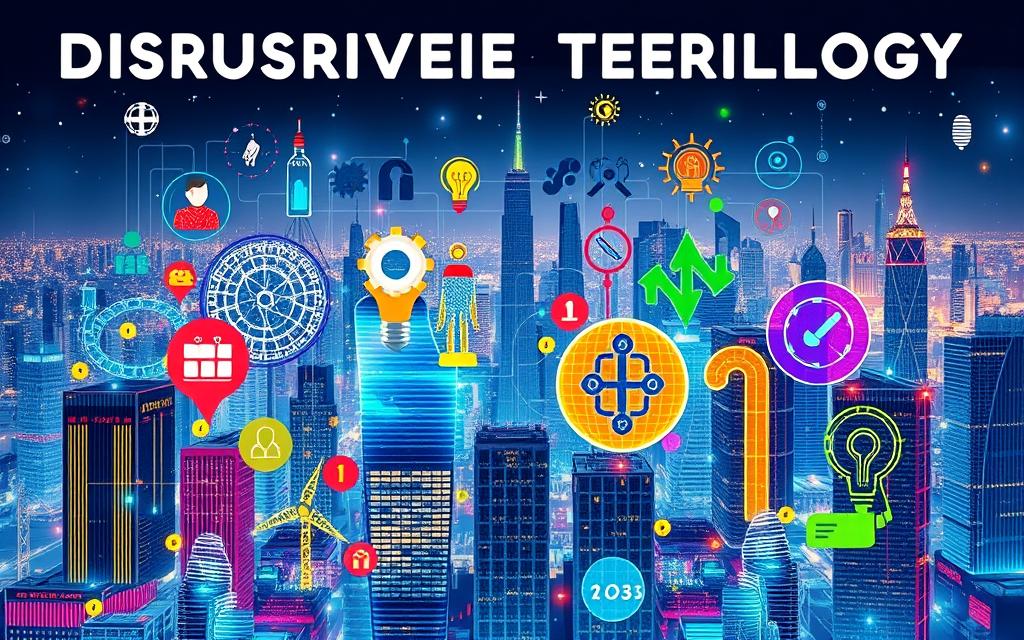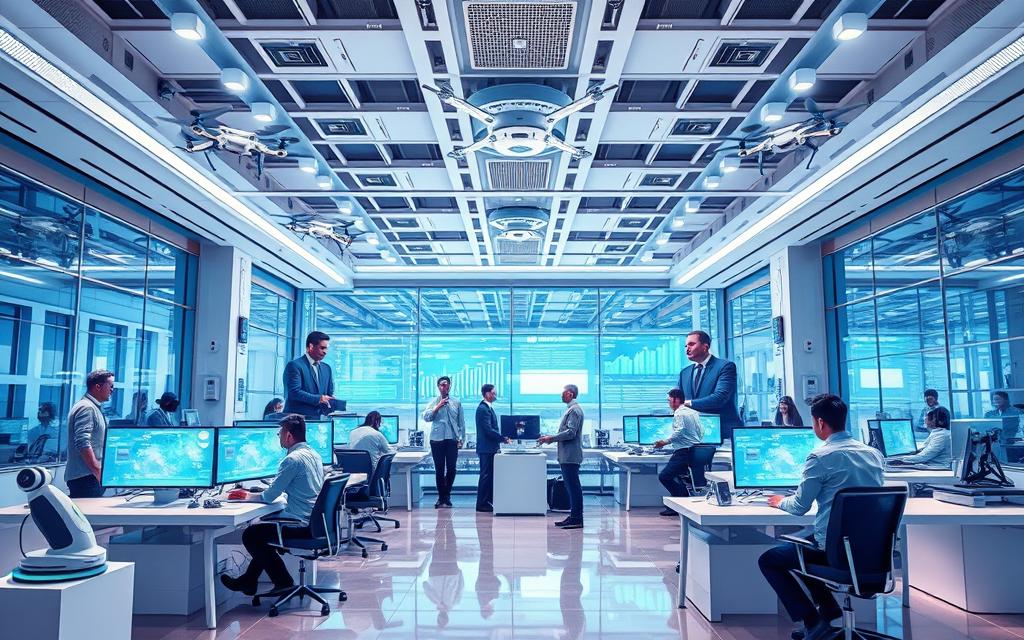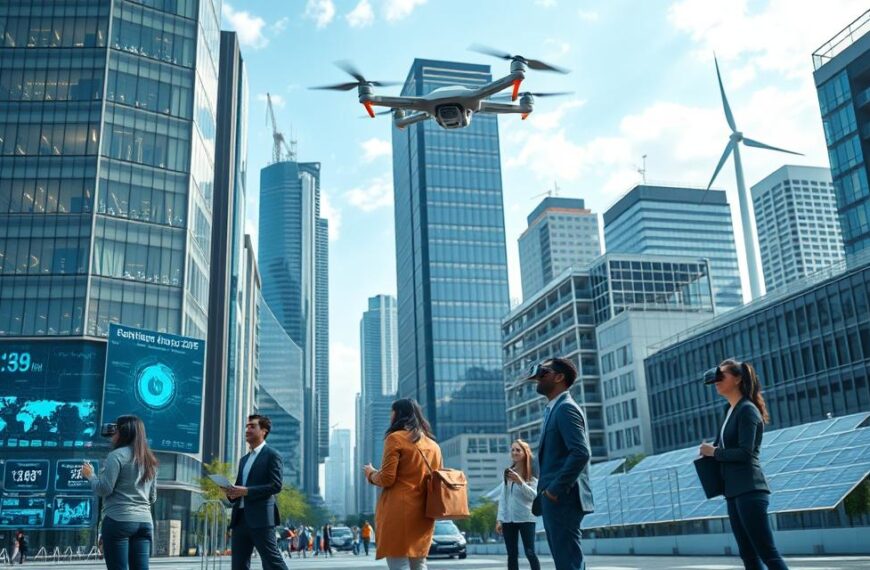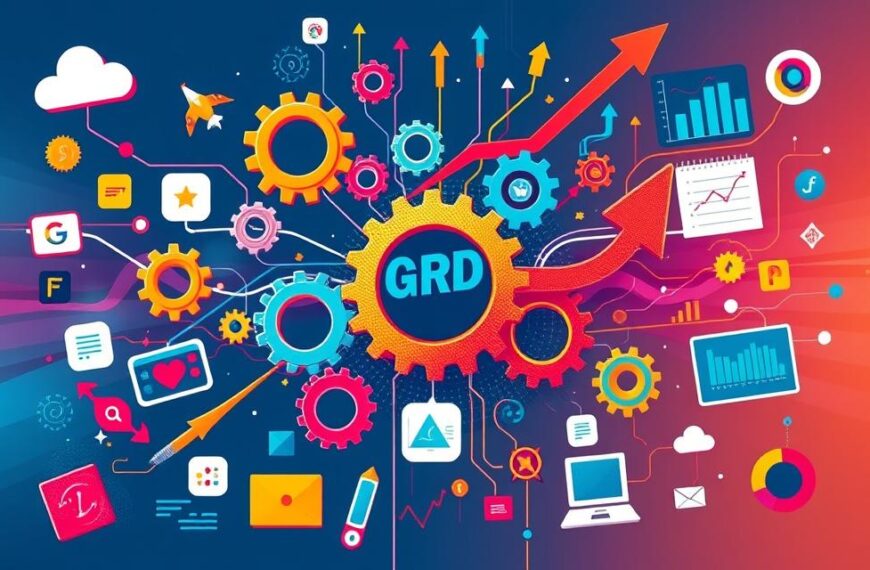Disruptive technology plays a key role in how businesses change today. They are new ways of doing things that shake up how we live and work. Clayton Christensen introduced this idea in 1995, showing how small companies can disrupt the market.
The internet and smartphones have changed how we behave and buy things. Now, things like online shopping and taxis you book on your phone are changing industries. A report says these technologies could make between $14 trillion and $33 trillion every year by 2025. It’s important for businesses to understand this to succeed in a changing world. Learn more about these technologies here: technologies transforming modern business.
Understanding Disruptive Technology
Disruptive technology changes how we live and work in big ways. It makes products and services cheaper and easier to use. This creates new markets and changes old ones. For example, personal computers and mobile phones have changed how we communicate and do business.
Definition of Disruptive Technology
The definition of disruptive technology talks about innovations that shake up the market. Small companies often start these changes. They introduce new ways of doing things, challenging the big players. Clayton Christensen first talked about this concept in 1995. He showed how new technologies can threaten established businesses.
Historical Context and Evolution
Looking back shows how disruptive innovation has reshaped industries. Companies that adopted these technologies have gained a lot. From e-commerce to ride-sharing apps, and GPS systems, each innovation forced old businesses to adapt. Now, technologies like blockchain and artificial intelligence are pushing industries like finance and manufacturing to evolve.
What Is Disruptive Technology in Business
Disruptive innovation is key for market change in various industries. It brings new business models and changes how consumers act. Companies that can adapt quickly may gain a competitive edge.
The Role of Disruptive Innovation in Market Change
Disruptive innovation reaches out to customers who were ignored before. It offers simpler, cheaper solutions than traditional methods. This lets new companies enter the market and even create new ones, causing major industry changes. Nowadays, nearly 63% of businesses are ready for disruption, but 44% are highly vulnerable to changes. This uncertainty highlights the importance of adapting to disruptive trends.
Comparison with Sustaining Innovation
Sustaining innovation is about making small improvements. It keeps things working as they are but doesn’t lead to big industry changes. For example, Henry Ford’s assembly line made cars more accessible to more people. Tesla, however, started by aiming at the luxury market, not changing the industry from the start.
Different innovation types show how disruptive technologies are crucial. Smartphones are a great example. They made internet access cheaper and changed how we use software, affecting the PC market greatly.
| Innovation Type | Definition | Market Impact |
|---|---|---|
| Disruptive Innovation | Targets less-demanding customers with lower-cost solutions | Creates new markets; enables new entrants to gain market share |
| Sustaining Innovation | Improvements on existing products or services | Maintains current market position; often overlooks emerging demands |
Categories of Disruptive Technology
Understanding the categories of disruptive technology is essential for businesses wanting to stay ahead. These technologies fall into two main types: low-end disruption and new-market disruption. Each type provides unique chances for both businesses and consumers.
Low-End Disruption
Low-end disruption happens when businesses offer simpler, cheaper products. These attract those underserved by existing options. It usually aims at customers who don’t need all features of pricier products. Netflix is a good example. It disrupted Blockbuster by providing a less costly, more convenient service.
New-Market Disruption
New-market disruption, on the other hand, opens up completely new markets. It reaches out to people who before had no interest or access to the traditional offers. Tesla is a prime example. With its luxury electric cars, it reached people not catered for by usual petrol cars. Investments in new-market technologies can bring large benefits as these areas grow.

Recognising the difference between low-end and new-market disruption helps businesses spot areas for growth. Focusing on sectors with strong potential returns prepares companies to excel in changing times.
| Type of Disruption | Description | Example |
|---|---|---|
| Low-End Disruption | Targets less demanding customers with simpler products. | Netflix disrupting Blockbuster. |
| New-Market Disruption | Creates new markets by appealing to previously non-existent customer bases. | Tesla’s luxury electric vehicles. |
Examples of Disruptive Technologies
Disruptive technologies have changed many industries, showing their deep effects on how companies work and how customers act. We will look at some key examples of this change. These include how e-commerce has affected retail, the makeover of transport by ride-sharing, and 3D printing’s role in making.
Impact of E-Commerce on Retail
E-commerce has greatly changed the retail scene. Online shops offer more convenience and a bigger choice of products. This makes traditional retailers change how they sell. Amazon is a leader in this, forcing others to come up with new ideas to keep up. Now, physical stores are mixing in-store shopping with online options for better customer experiences.
How Ride-Sharing Apps Transformed Transportation
Uber and Lyft have changed city travel. They provide cheap and efficient ways to get around, changing how taxis work and how people decide to travel. This ride-sharing change not only shows the desire for services on demand. It also starts talks on how travel must be regulated and how it can be more sustainable.
The Rise of 3D Printing and Its Influence on Manufacturing
3D printing is changing making by allowing quick, on-demand and custom production. This lets makers cut down on time and costs, changing how things are made and sent. 3D printing in manufacturing shows a new chance for designing products and making unique items for each customer.
These examples show the big role disruptive tech plays in businesses today, stressing the need for companies to change and create new things to stay in the game. For more on how AI can help businesses amid these changes, check out how AI is transforming operations.
Implementing Disruptive Technologies in Your Business
Being open to new technologies is key. Companies must look for chances to shake up the market. They should understand their current way of doing things and spot new tech trends.
This helps find spots where they can bring in something fresh.
Identifying Opportunities for Disruption
First, companies need to see what people need and how they act. Tech like cryptocurrency is changing the finance world. This opens up ways to grow. By looking closely, companies can find where they can change things for the better.
Best Practices for Integration
Bringing in new tech needs careful planning. Setting clear goals helps steer everything in the right direction. Teaching staff new skills is crucial for success in a changing world. Important steps include:
- Talking with stakeholders early to build commitment.
- Using clear goals to monitor success and impact.
- Being ready to tweak plans after looking at results.
- Providing ongoing training on the latest trends.
Following these best practices makes integrating new tech smooth. It creates a workplace that’s ready for innovation. Embracing change puts companies ahead in the fast-moving market. For tips on winning with new tech, business leaders can look at custom strategies here.
Conclusion
Disruptive technologies are changing the way we do business. They are powerful tools that reshape the business world. Organisations that use these innovations can get ahead of the competition. The invention of the steam engine and the spread of electricity are key examples. They show how new technologies can permanently change industries and how people act.
The future of business innovation means embracing these technologies is essential. From a few thousand in 2010, electric car sales shot up to millions by 2020. This shows how fast technology is adopted. Companies must adapt quickly, make fast decisions, and create prototypes to stay in the game.
This summary reminds us that companies must embrace innovation. As Clayton Christensen said, even if new technologies struggle at first, they can completely change the norm later. By investing in these innovations, businesses can succeed in a changing market. For more information on how AI is changing the business world, click here.
FAQ
What is disruptive technology?
Disruptive technology brings new ways of doing things, changing how we live and work. It offers affordable solutions, often shaking up traditional markets. Companies, especially smaller ones, can reach customers who were previously ignored.
How does disruptive technology differ from sustaining innovation?
Disruptive innovation makes things simpler and cheaper for less-demanding customers, opening new markets. Sustaining innovation, however, improves existing products without creating new markets. It helps companies keep their current customers.
Can you give examples of disruptive technologies?
Sure, the internet and smartphones have changed how we connect and share information. E-commerce sites, ride-sharing apps, and 3D printing have all disrupted their fields. They’ve made products and services easier for everyone to get.
What are the categories of disruptive technology?
There are two kinds: low-end disruption, for those happy with less than the top-tier products, and new-market disruption. The latter finds new customers, those who haven’t used such products before.
How can businesses implement disruptive technologies?
Companies should look for innovation chances and assess their current methods. They need a plan with clear goals. Teaching their teams about the technology and adapting flexibly are also key to success.
What is the impact of e-commerce on traditional retail?
E-commerce has changed shopping by making it more convenient and giving a wider choice. Traditional shops must now think digital to stay in the race.
How have ride-sharing apps transformed urban transportation?
Apps like Uber have made city travel cheaper and more convenient. This is a big challenge for old-school taxis and has changed how people move around in cities.

















